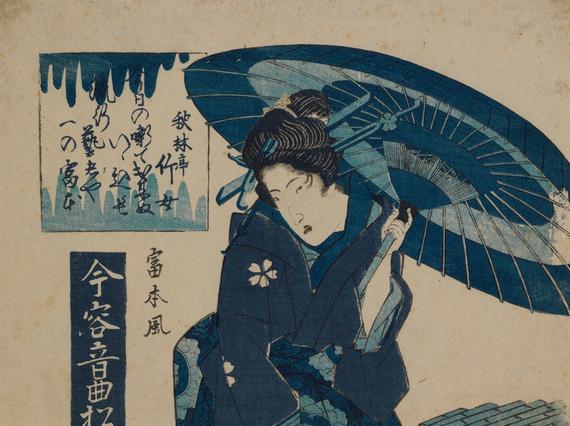
East Asia in Glasgow and Strathclyde
Find out more about East Asian collections in East Ayrshire, East Dunbartonshire, East Renfrewshire, Glasgow City, Inverclyde, North Ayrshire, North Lanarkshire, Renfrewshire, South Ayrshire, South Lanarkshire and West Dunbartonshire.
East Ayrshire
The Dick Institute, East Ayrshire Leisure
The Dick Institute, East Ayrshire Leisure, has a large Chinese numismatic collection of 357 coins. Other items include children’s shoes, purses, chopsticks, stone specimens of fruit, soapstone ornaments, opium pipes and a helmet. Within the Japanese collection there are arms and armour, a WW2 Japanese flag, masks, numismatics, figurines, models, dress and accessories.
Glasgow City
Glasgow Museums, Glasgow Life
There are approximately 4,620 items in Glasgow Museums combined East Asian collections; this total includes the objects at Kelvingrove Museum, The Burrell Collection and Glasgow Museums Resource Centre. The Chinese collection includes lacquer ware, furniture, sculpture, paintings on silk and pith, prints, calligraphy, textiles, musical instruments, metalwork, jade, numismatics, maps, and offertory goods. Japanese objects include woodblock prints, paper samples, lacquer ware, ceramics, musical instruments, metalwork, textiles, plaster masks, carved ivory, cloisonné parasols, and furniture. There are also Korean items in the collections – mainly ceramics, metalwork, dress and accessories.
The East Asian collections at Glasgow Museums are particularly strong, owing to donations made by Sir William Burrell (1861-1958) and the Meiji Government (1868-1912). Sir William Burrell amassed around 1,800 Chinese artefacts over a 75-year period of collecting, purchasing Chinese artworks regularly between 1911-1954. The Meiji Government gave over 1,000 items to the City of Glasgow in November 1878 as part of a Glasgow-Japan exchange of industrial samples and products.
East-Asian musical instruments from Henry Dyer’s collection were lent to the museum in 1906 and bequeathed in 1937.
Special Collections at The Mitchell Library, Glasgow Museums and Collections, Glasgow Life
There are 199 East Asian items in the Special Collections at The Mitchell Library, mainly composed of Japanese objects from the Henry Dyer Collection. The Japanese 18th -19th century paintings, prints and albums were possibly acquired in Japan while Henry Dyer was employed at the Tokyo College of Engineering between 1873-1882.
Reverend W Campbell and John Cowie both donated Chinese pith paintings to Special Collections, The Mitchell Library.
The Hunterian, University of Glasgow
The largest number of Chinese objects at The Hunterian comprise James McNeill Whistler’s ceramic collection of around 330 items, donated by Whistler’s sister-in-law Rosalind Birnie Philip in 1938 and upon her death in 1958. Philip also added to the Whistler collection after she became chief executor of the will in 1903. In addition, there are approximately 80 coins and 150 ethnographic and archaeological items including jade and ceramics.
A rare object in the collection is A Map of the Whole World by Ferdinand Verbiest, 1674, showing the two hemispheres of the world. The map was designed for the Chinese Emperor Kangxi (1662-1722) by the Jesuit Father Ferdinand Verbiest (1623-88), in 1674.
The print collections are formed from the Gilbert Innes collection of woodblock prints and the Rosalind Birnie Philip donation of the James McNeill Whistler collection of woodblock prints. A small number of Japanese ceramics came to the museum via the Rosalind Birnie Philip Bequest. A further 30 items are in the ethnographic collections.
There are Korean objects in the collection: a seal-box and some samples of paper sheets.
Inverclyde
The McLean Museum and Art Gallery, Greenock
There are around 510 East Asian artefacts in the collection at the McLean Museum. The Japanese material forms one of the most significant parts of the World Cultures collection in terms of scale and quality. The Chinese objects include export and domestic wares, mainly from the latter part of the Qing dynasty (1644-1912) and from the early period of the Chinese Republic (1912-1949).
The Japanese items generally date from the 16th century onwards. This part of the collection includes armour, swords and sword fittings, tsuba, lances, ceramics, inrō, lacquer ware, netsuke, printed items, wood carvings, equestrian items and costume. The main donor involved in the acquisition of the Japanese material was George Rodgers Macdougall (1843-1917).
Renfrewshire
Paisley Museum, Renfrewshire Leisure
Paisley Museum has a large collection of ivories, ceramics, metalwork and cloisonné from Japan and China. The Japanese collection at Paisley Museum was shaped by donations from the educationalist and ethnographer, James Main Dixon (1856-1933) and United Presbyterian Church missionary, John Henderson. Henderson’s attempts to establish a Temperance Hall in Japan in the 1870s-1880s were part-funded by Sir Peter Coats, of J & P Coats. Sir Peter Coats also funded the development of Paisley Museum’s art and sculpture galleries in 1882.
Dixon, originally from Paisley, was employed by the new Meiji Government at the University of Tokyo during the 1880s as a teacher of English. In 1882, Dixon visited Ezo (Hokkaido) and collected items created and used by the Tsuishikari people. This small group of Ainu artefacts is a highlight of the collections.
South Lanarkshire
South Lanarkshire Leisure and Culture
South Lanarkshire Leisure and Culture has a small collection (under 100 items currently identified) mainly from the The Cameronians (Scottish Rifles) regimental collection. Ceramics and glassware and some numismatic collections come from pre-South Lanarkshire Council era museum collections from Rutherglen and Strathaven/East Kilbride (John Hastie Museum).
The Chinese objects include souvenir items collected by The Cameronians (Scottish Rifles) who served in China in 1927. Sketchbook and associated prints by H H Crealock – an officer of the 90th Perthshire Light Infantry (an antecedent regiment of The Cameronians SR) who served as a general officer and unofficial war correspondent in several Victorian military campaigns, including the Second Opium War (1857-1860). There is a small collection of Japanese edged weapons, Japanese flags/ banners and souvenir items collected by 1st Battalion The Cameronians (Scottish Rifles) during their service in the Pacific War/Second World War (1941-1945).